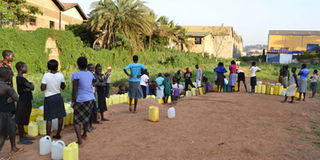Why there are long queues for water

Residents of Naguru Police Barracks in Kampala collect water from a well. Naguru Police barracks and Kyengera are some of the areas affected by water shortage, which has forced NWSC to start rationing water. Photo by Stephen Otage
Florence Nansubuga’s patience is being worn thin by water rationing. The nursing student at St Francis Nyenga School of Nursing, Mukono and a resident of Nakabago has had to adjust her schedule to accommodate water scarcity.
“You have to wake up very early to fetch the water and any delay means you will wait until late in the night or the following morning,” she grumbles.
Like Nansubuga, other residents of Nakabago village are also grappling with the dry water taps, as they have, since early January.
How people are coping
Harriet Namuli, another resident, says they have opted to fetch the water from a well they referred to as “Kigaga” because the tap water from the National Water and Sewerage Corporation (NWSC) is no longer reliable.
Some casual labourers are taking advantage of the scarcity to fetch water for the residents. Namuli says they charge Shs500 or Shs700 for a jerrycan, depending on the distance from the well.
She points out that the water from the well is, however, no longer as clean as it once was since there are many people encroaching on it, contaminating it in the process.
The most affected areas
This water scarcity is not only hitting Mukono District. Similar scenarios are happening elsewhere especially in Kyengera, Nsangi, Mpigi and other areas in Wakiso district.
“The only affected areas are those that lie at the periphery of the network in Wakiso and Mukono but water supplies remain normal for the rest of Kampala. In fact, you may not notice that we are having shortages,” Sam Apedel, NWSC’s public relations manager, says. The peripheries of Kampala, he explains, include parts of Kawanda-Namulonge, Seeta-Mukono, parts of Nabweru and Maganjo-Kagoma, among others.
Why now?
Apedel attributes the water shortages to growing demand, and ongoing repair work at the Ggaba water treatment plant.
Environment minister, Ephraim Kamuntu also blames the water shortage to the increasing population, which is growing at a faster pace than the water supply network. However, he also blames consumers for not being proactive.
Uganda, he said, has two rain seasons – March to May and September to November – and thus, people should not be lamenting about water shortages.
“When you move across the country you find that people have built good houses but when it rains, they wait in their homes and after send their girl children to go and fetch water yet it has been raining,” he said.
Apedel also says the corporation, which supplies 200 million litres of water to the city daily, has a deficit of 40 million litres needed for city dwellers and the surrounding areas.
In addition to this, the corporation had to store more water after the Uganda National Meteorological Authority, announced last month that a dry season, which started in December last year, would continue until the end of February. With the dry season comes a higher demand for water and therefore NWSC has had to come up with measures to address these problems.
The solutions
The measures, Apedel explains, include rationing water in the short term, which means some places will have water while others do not, at a given time.
He adds that NWSC is also sinking new boreholes, installing boosters and doing network intensifications in the affected areas to increase availability of water.
In the long run, the current renovations on the Ggaba treatment plant, expected to be completed in August, mean that supply of an extra 50 million litres of water will be possible, addressing the current deficit. Apedel also says another 120 million litres will be available from the Katosi treatment plant by 2016.
It also calls for implementation of government policy to promote not only the conservation of the environment – trees – which, during precipitation, inadvertently contribute to forming water, but also water harvesting.
The environment minister also supports this idea, saying all public buildings should have water harvesters. He says, during the colonial time, government structures had to harvest water; and reviving such an initiative should be supported by everyone.
Kamuntu also says harvesting water will save the country from spending a lot on water hygiene-related diseases and also save children from walking long distances in search of water.
According to the World Bank’s Water and Sanitation Programme, an estimated Shs389b is lost annually in treating diseases such as diarrhoea, cholera, intestinal worms, bilharzia, trachoma, typhoid fever.
These are diseases connected to coming in contact with contaminated water, something which is wont to happen when there is a shortage of treated or safe water.
The cost of treating these diseases would therefore be better suited to having a steady supply of water in the country.
However, even as these solutions are being implemented, everyone is encouraged to take advantage of whatever rain pours, to harvest water.




